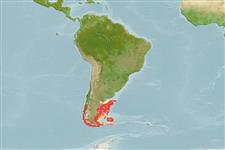Common names from other countries
Classification / Names / Names
Nomi Comuni | Sinonimi | Catalog of Fishes (gen., sp.) | ITIS | CoL | WoRMS
Environment: milieu / climate zone / depth range / distribution range
Ecologia
; salmastro; distribuzione batimetrica 0 - 100 m (Ref. 356). Temperate, preferred 10°C (Ref. 107945); 40°S - 56°S, 76°W - 36°W
Southeast Pacific, Southwest Atlantic and the Antarctic.
Length at first maturity / Size / Peso / Age
Maturity: Lm ? range ? - ? cm Max length : 18.0 cm SHL maschio/sesso non determinato; (Ref. 356)
This is an epifaunal species found on soft sandy and muddy bottoms and diverse rocky substrates including cobbles and associated with holdfasts or fronds of brown algae in inner fjords, channels and exposed areas (Ref. 87801).
Life cycle and mating behavior
Maturità | Riproduzione | Deposizione | Uova | Fecundity | Larve
Members of the class Bivalvia are mostly gonochoric, some are protandric hermaphrodites. Life cycle: Embryos develop into free-swimming trocophore larvae, succeeded by the bivalve veliger, resembling a miniature clam.
Häussermann, V. and G. Försterra. 2009. (Ref. 87801)
IUCN Red List Status (Ref. 130435)
CITES status (Ref. 108899)
Not Evaluated
Not Evaluated
Human uses
Pesca: commerciale
FAO - Acquacoltura: production; pesca: landings | FishSource | Sea Around Us
Strumenti
Fonti Internet
Estimates based on models
Prior r = 0.43, 95% CL = 0.28 - 0.64, Based on 1 data-limited stock assessment.
Vulnerability
Low vulnerability (10 of 100).
